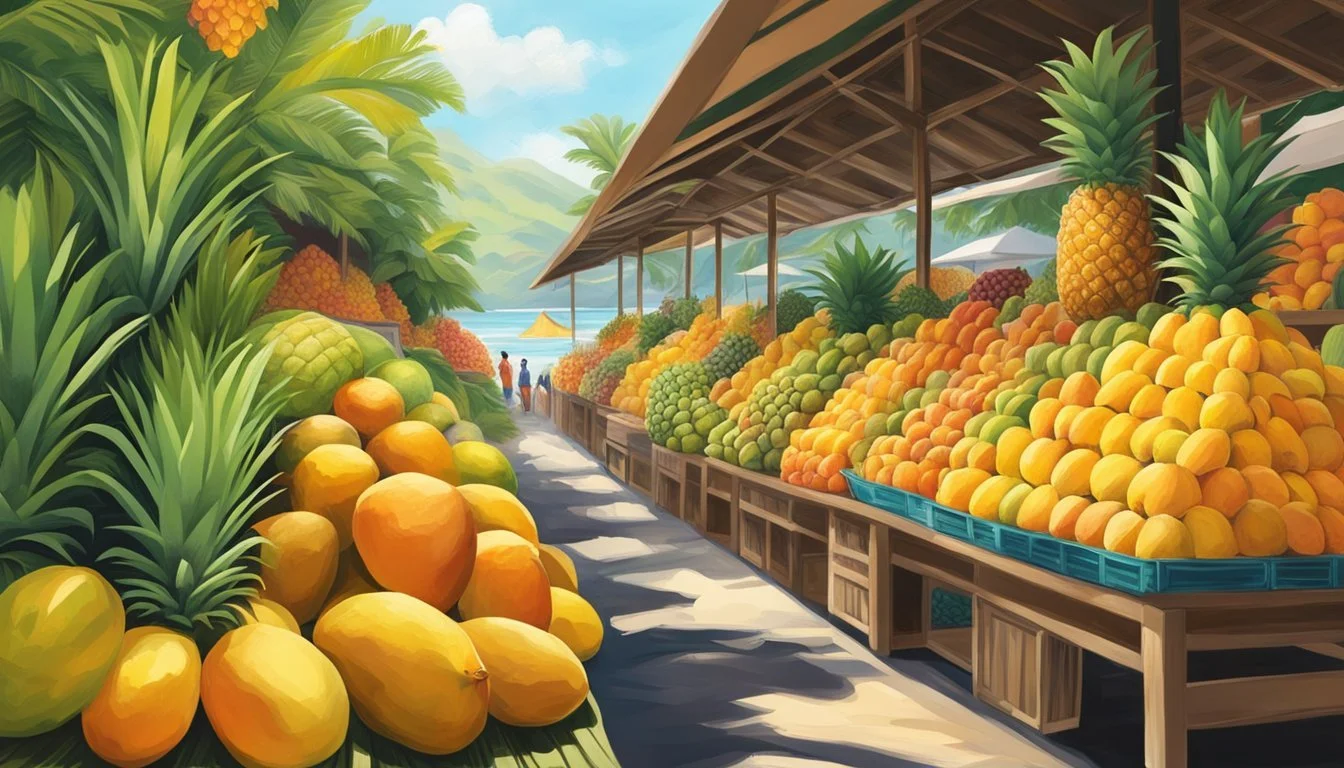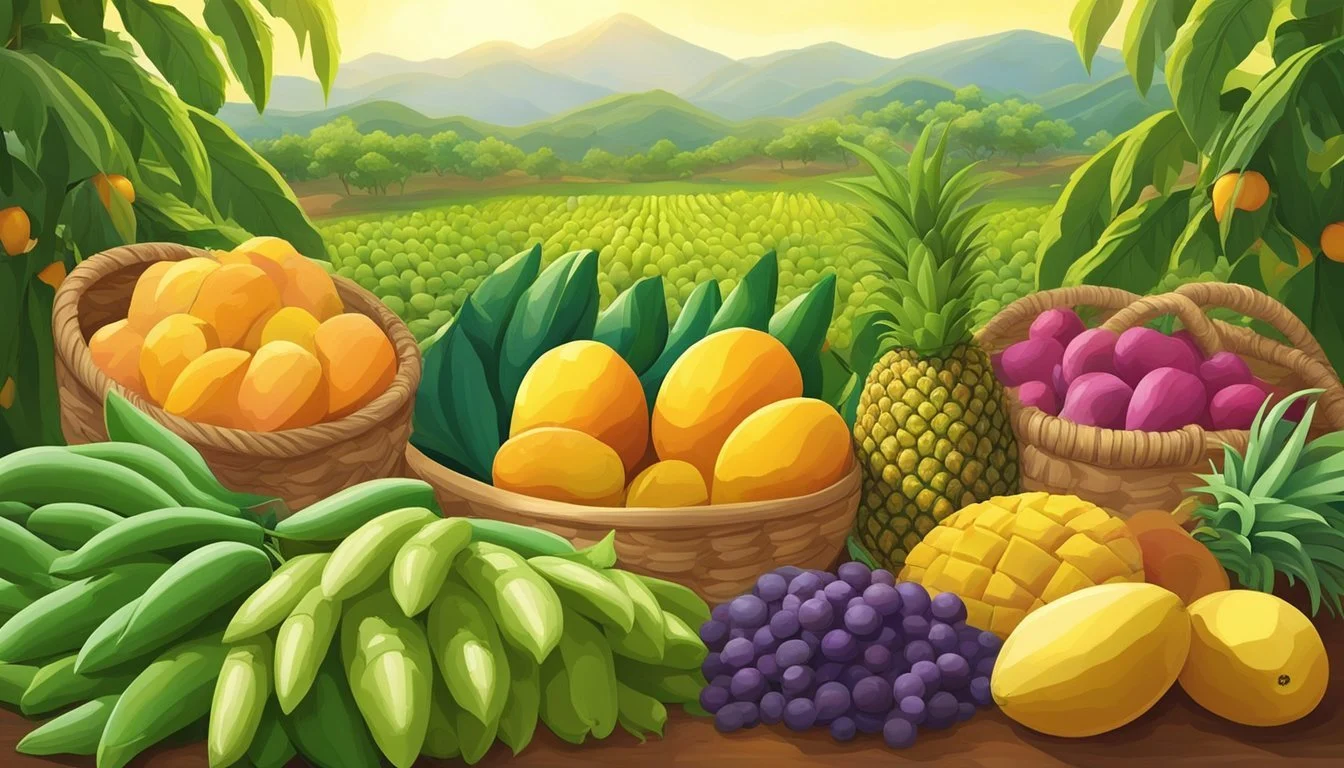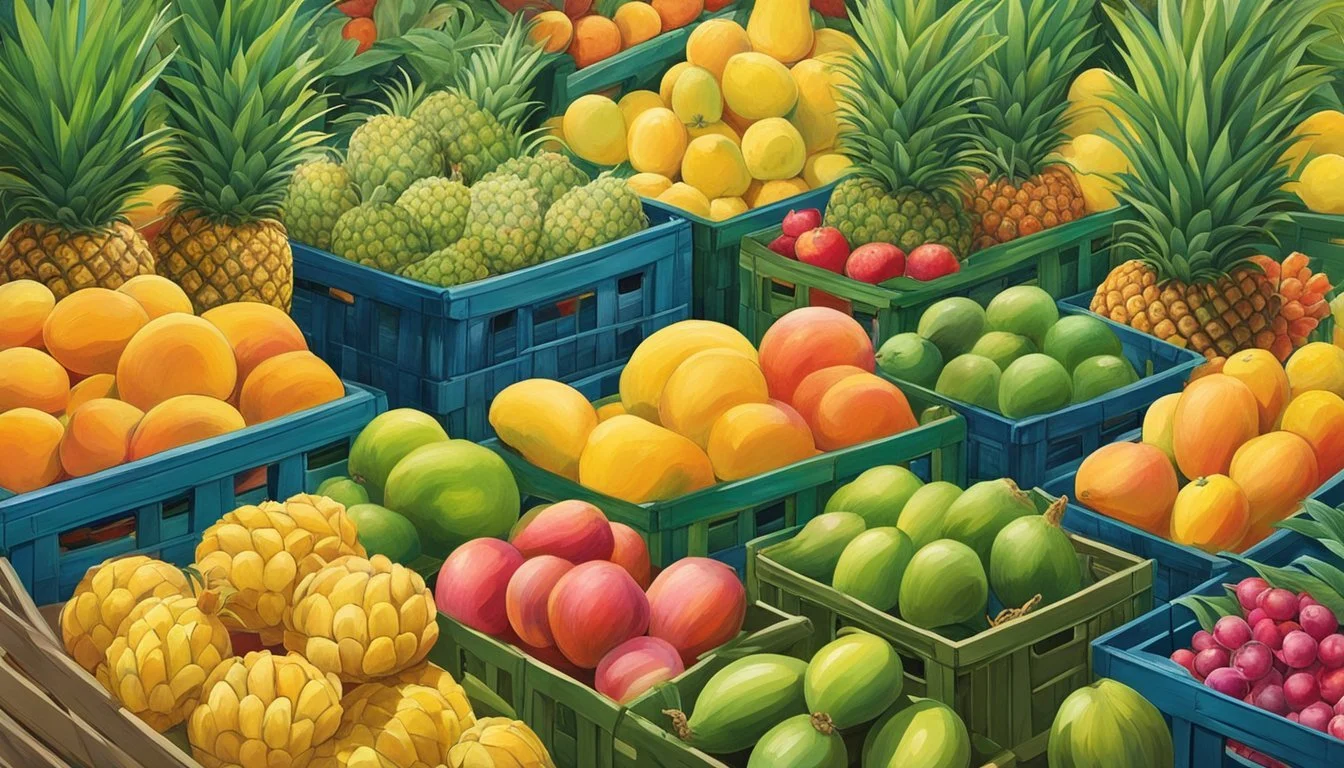Hawaii Seasonal Fruit & Vegetables in June
Your Fresh Guide
This Article is Part of our Hawaii Seasonal Fruit & Veg Calendar
Hawaii offers a lush, year-round growing climate that provides an abundance of fruits (What wine goes well with fruits?) and vegetables, with seasonal fluctuations allowing for a variety of produce to be at its peak quality. In June, when the summer season is blossoming, Hawaiian farms yield an array of vibrant fruits and vegetables, marking this month as a significant period for both local consumers and the agricultural community. Seasonal harvest is fundamental in the islands, ensuring the freshest and most flavorful produce is available while supporting sustainable farming practices.
Among the fruits reaching their peak in Hawaii during June are the sweet and compact apple bananas (how long do bananas last?), which stand out for their unique flavors reminiscent of apples (how long do apples last?)and strawberries. The warmth of the early summer months also heralds the best time for harvesting other tropical delights such as lychee, with its fragrant and juicy taste, and the plump, golden-fleshed mangoes known widely for their rich, succulent flavor. These fruits not only satisfy local palates but also contribute greatly to Hawaii's culinary identity, celebrated in many traditional and contemporary recipes.
Vegetables also thrive in Hawaii's June climate, with a variety of greens and root vegetables being harvested. Local markets and restaurants proudly showcase these seasonal selections, inviting both locals and visitors to indulge in and appreciate the island's agricultural heritage. The commitment to seasonal and regional produce reflects the Hawaiian community's dedication to environmental stewardship and the support of local economies.
Understanding Hawaii's Unique Agricultural Environment
Hawaii offers a rich tapestry of agricultural potential thanks to its tropical climate and innovative local farming practices. These elements combine to support a diverse range of crops, ensuring a year-round supply of fresh produce.
The Tropical Climate and Seasonal Cycles
Hawaii's agricultural environment is greatly influenced by its tropical climate, which provides warm temperatures and ample rainfall throughout the year. This climate allows for continuous growth cycles, and as a result, many crops can be grown throughout the year. The islands experience subtle seasonality:
Summer (June to October): Warm and dry
Winter (November to May): Cooler with more rainfall
Certain fruits and vegetables have peak seasons during these months, with June showcasing a variety of produce such as limes, which are available from June to March, and mangoes from March to November.
Local Farming Practices
Farmers in Hawaii employ sustainable and traditional methods that respect the islands' unique ecosystems. Their practices often include:
Utilization of organic farming techniques to maintain soil fertility without synthetic inputs
Preservation of native Hawaiian crops, which are adapted to the islands' specific growing conditions
Support of small farms and cooperatives, enhancing local food systems and reducing reliance on imports
This approach to agriculture not only supports Hawaii's economy but also ensures that the fruits and vegetables grown on the islands are of high quality. Hawaii's commitment to local farming practices contributes to the unique flavors and freshness of its produce, a testament to its symbiosis with the tropical environment.
June's Seasonal Fruits in Hawaii
In June, Hawaii's fruit selection is abundant, featuring the peak season for various tropical fruits while also offering a mix of citrus and berries.
Tropical Fruit Availability
Pineapple: This iconic fruit is sweet and juicy in June, widely available across the islands.
Mangoes: A variety of mangoes reach their peak ripeness, offering a range of flavors from tangy to very sweet.
Bananas: Found year-round, but June sees a particularly good harvest of these creamy, rich fruits.
Lychee: With a short season, June is an ideal time to enjoy lychee’s fragrant and sweet taste.
Starfruit: Known also as carambola, this fruit's waxy skin hides a tart, juicy interior, commonly found in June.
Papayas: Sweet and flavorful, papayas are harvested at their prime during this month.
Citrus and Other Fruits
Lime: Continues to be available, offering a fresh, zesty flavor to a variety of dishes and beverages.
Guava: Ranges from sweet to slightly sour, found in backyards and markets alike in June.
Berry Varieties in June
Strawberries: While not as common, strawberry crops can be found and are typically at the end of their season.
Blueberries: Some farms may offer blueberries in June, but they are less common compared to other Hawaiian fruits.
Hawaiian Vegetables Peaking in June
In June, the Hawaiian islands' fertile volcanic soil and warm weather support a variety of vegetables reaching their peak. Many root vegetables and leafy greens are harvested during this month, alongside a diverse mix of other vegetable varieties.
Root Vegetables and Tubers
Sweet Potatoes: Known as 'uala in Hawaiian, sweet potatoes thrive in Hawaii's climate and are typically ready for harvest.
Radishes: They are quick to mature and can be found fresh in local markets.
Leafy Greens and Herbs
Spinach: This nutrient-rich leafy green is available from local farms.
Cabbage: Both traditional head cabbage and Asian varieties are abundant, catering to diverse culinary practices on the islands.
Other Vegetable Varieties
Zucchini and Squash: These gourds are commonly harvested in June, versatile for a range of dishes.
Beans: Various beans, including string beans, are in season and offer a fresh, crisp addition to meals.
Harvesting and Consumption Tips
Hawaiian fruits and vegetables peak in June, offering a fresh bounty ready for consumption. This section outlines how to pick these items at their best, store them properly, and prepare them to maximize flavor and nutrients.
Optimal Picking Times
Bananas: These are best harvested when the skin is still slightly green, indicating ripeness without over-softening. In June, they should detach easily from the bunch.
Cantaloupe (how long does cantaloupe last?): A ripe cantaloupe will have a sweet aroma at the blossom end and a slight give when pressed. They should be picked when the netting pattern on the skin is prominent and the background color changes from green to tan or yellow.
Storing for Freshness
To ensure Hawaiian produce maintains freshness after purchase:
Bananas: Keep at room temperature to allow even ripening. Once ripe, one can refrigerate them to slow down the ripening process.
Cantaloupe: Store uncut melons at room temperature. Once sliced, keep them in an airtight container in the refrigerator.
It is important to note that grocery stores often have their own storage methods, optimizing the shelf life of produce, while farmers may provide insights into best practices for at-home storage.
Preparing Hawaiian Produce
When preparing Hawaiian produce:
Bananas: Peel and consume fresh, or slice and add to cereals or smoothies. For a frozen treat, bananas can be peeled, sliced, and frozen for later use.
Cantaloupe: Rinse the outer surface before cutting to prevent transferring any impurities from the rind to the flesh. Cut the melon in half, remove the seeds, and slice or cube the fruit as desired.
Both harvested fruits are versatile and can be incorporated into various dishes to add a tropical touch.
Where to Find and Buy Local Produce
In June, those seeking the freshest local fruit and vegetables in Hawaii have several reliable options. Here's where a buyer can confidently purchase seasonal items like honeydew, limes, longan, lychee, and mango.
Farmers' Markets
Farmers' markets are an excellent source for local produce in Hawaii. Shoppers can find a variety of fruits and vegetables often picked at the peak of ripeness. The Farm presence is strong, with farmers bringing their fresh picks directly to consumers. Here’s a quick list of some markets to visit:
Honolulu Farmers' Market: Offering a vast selection of tropical fruits and local specialties.
KailuaTown Farmers' Market: Known for its abundance of organic produce.
Grocery Stores and Supermarkets
Many grocery stores in Hawaii stock local fruit whenever possible to support regional agriculture. These stores often label local items to distinguish them from imported goods. Shoppers should look for signs indicating something is locally grown to ensure they are buying Hawaiian produce. Notable grocery stores include:
Foodland: Often has a section for Hawaii-grown fruit and vegetables.
Safeway: Look for the "Locally Grown" tags in the produce aisle.
Specialty Health Food Stores
Specialty health food stores are ideal for finding local, organic, and sometimes rare produce. They tend to have a close relationship with local farmers and can offer unique finds that may not appear in larger grocery stores. Some noteworthy health food stores include:
Down to Earth Organic & Natural: With multiple locations, they offer a diverse assortment of organic local fruit and vegetables.
Mana Foods: A well-regarded store in Maui that sources from local farms.
Health Benefits and Nutritional Information
Eating seasonal fruits and vegetables in Hawaii provides not only fresh, delicious produce but also impressive health benefits and nutritional content. Tropical fruits available in June, such as mango, lychee, and banana, are teeming with vitamins and minerals, while seasonal vegetables offer a range of health benefits from nutrient diversity.
Tropical Fruits Nutrients
Tropical fruits in Hawaii boast a myriad of essential nutrients. For instance:
Mangoes are rich in vitamin C, vitamin A, and fiber.
Lychee contains a good amount of vitamin C, vitamin B6, niacin, riboflavin, and folate.
Bananas, particularly the smaller apple bananas which are sweeter and contain flavors of apples and strawberries, provide potassium, vitamin C, and dietary fiber.
Fruit Key Nutrient Health Benefit Mango Vitamin C Antioxidant properties, aids in collagen production Lychee Vitamin B6 Supports metabolism, brain health Banana Potassium Helps regulate fluid balance, muscle contractions, and nerve signals
Benefits of Eating Seasonal Vegetables
Seasonal vegetables are low in fat and calories but dense in vitamins, minerals, and dietary fiber, which promote overall health. They help ensure a diverse diet, which can reduce the risk of chronic diseases and support healthy bodily functions. Some key points include:
Vegetables like cantaloupe and honeydew available in June are high in vitamins A and C.
Including a variety of colors and types of vegetables in one's diet can help reduce cancer risk and support immune function.
Vegetable Nutritional Composition Potential Health Benefit Cantaloupe Vitamin A & C Supports immune system, vision, and skin health Honeydew Vitamin C & Potassium Antioxidant properties, maintains blood pressure
Consuming fruits and vegetables when they are in season ensures peak nutritional value and flavor, contributing significantly to a well-rounded, healthful diet.
Culinary Uses and Popular Recipes
Hawaii's June bounty offers a rich palette for both traditional recipes and modern culinary experiments. The availability of fresh mangoes, avocados, cantaloupes, and oranges supports a wide range of dishes from classic luau fare to innovative fusion cuisine.
Traditional Hawaiian Dishes
In June, traditional Hawaiian dishes take full advantage of the seasonal fruits available. Luau attendees may find themselves enjoying:
Poi: Made from taro root, this staple can be served alongside dishes enhanced with seasonal fruits.
Mango Salsa: Mangoes provide a sweet yet tangy flavor to this versatile salsa, often paired with fish or pork.
Lilikoi Juice: The passionfruit, known locally as lilikoi, is commonly used to make a refreshingly tangy beverage.
Modern Fusion and Trends
Chefs in Hawaii are continuously innovating to create modern takes on classic dishes:
Avocado Toast: Avocados from Hawaii are spread thickly on artisanal bread, topped with slices of apple bananas for a truly tropical twist.
Exotic Fruit Salads: Combining mangoes, pineapple, and other exotic fruits with local greens offers a fresh, nutritious option.
Coconut Water Smoothies: A hydrating and nutritious base for smoothies that incorporate cantaloupes and oranges for natural sweetness.
Preservation and Canning
The abundance of fruit in June also leads to preservation methods to extend their use:
Mango and Pineapple Chutney: Perfect for canning, these chutneys capture the essence of Hawaiian summer fruits for year-round enjoyment.
Apple Banana Applesauce: A spin on traditional applesauce, using apple bananas for their unique flavor and sweetness.
Cantaloupe Jam: This melon can be transformed into a delightful jam, preserving its June freshness for months to come.
Challenges and Considerations for Local Farmers
In Hawaii, local farmers face distinct challenges due to the archipelago's unique environmental conditions and economic landscape. These factors critically influence the success of growing and marketing Hawaiian fruit and produce, particularly in the tropical climate of springtime.
Weather and Environmental Factors
Hawaii's tropical climate, while conducive to growing a diverse array of fruits and vegetables year-round, also presents unpredictable weather patterns that can greatly affect crop yield. Spring time in Hawaii, which includes the month of June, transitions from the rainy season, potentially bringing late storms that can cause flooding and crop damage. Farmers must consider:
High Humidity and Precipitation: Favors growth of certain crops but also promotes plant diseases.
Sun Exposure: Varies across the islands, influencing where certain fruits and vegetables thrive best.
Economic and Market Dynamics
The economics of farming in Hawaii includes both local and external market forces that impact the viability of cultivating Hawaiian fruit and produce. Local farmers navigate:
Costs: High land and labor costs challenge profitability.
Supply Chain: Dependency on imports for farming supplies can disrupt operations.
Local Market Demand: While there is demand for local produce, competition with imported goods affects sales.
Export Potential: Limited by costs and logistics, yet profitable for certain high-value crops.
Supporting Hawaii's Agricultural Economy
Purchasing locally-grown produce and participating in farm-related tourism are critical actions that bolster Hawaii's agricultural sector. These efforts ensure the sustainability of Hawaiian farming and offer a unique insight into the local culture and economy.
The Importance of Buying Local
Local Farmers and Economy: When buyers prioritize Hawaiian fruit and vegetables, they directly support local farmers whose livelihoods depend heavily on the local market. Consumer spending on local produce keeps financial resources within state borders, reinforcing the entire local economy.
Freshness and Quality: Hawaiian fruit, renowned for its exceptional taste and quality, reaches consumers at its peak when purchased locally. This supports a healthy community and provides an incentive for farmers to continue cultivating a diverse range of crops.
Environmental Impact: Choosing local fruit limits the need for long-distance transportation and associated emissions, thereby playing a role in environmental conservation.
Agritourism and Farm Visits
Engagement with the Farm Experience: Tourism is an integral part of Hawaii's economy. Visitors interested in Hawaiian travel can enrich their experience by engaging in agritourism. Farm visits allow tourists to explore the agricultural landscape, meet the farmers, and learn about the cultivation of local fruit first-hand.
Cultural Significance: Agritourism offers a genuine connection to Hawaiian heritage through the lens of agriculture, introducing travelers to traditional and contemporary farming practices.
Economic Benefits: Both the farm and the wider community profit when tourists partake in agricultural activities, whether it be picking local fruit or touring the farms, boosting the economy and promoting sustainable tourism.
Hawaiian Fruit FAQs
What fruits are in season in Hawaii in June?
In June, Hawaiian markets and farms offer a variety of fresh, seasonal fruits, such as:
Lychees: Sweet and fragrant with a balance of tartness.
Mangoes: Typically juicy with a fibrous, sweet flesh.
Bananas: Local varieties present, each with a distinct taste and texture.
Rambutans: Related to lychees, these have a juicy, sweet taste with a slightly floral note.
Papayas: Offered in various sizes, ripe papayas are sweet with a creamy texture.
How can one identify a ripe lychee?
Ripe lychees have a red or pinkish skin and are slightly soft to the touch. They should also have a sweet fragrance.
What are noni fruits, and can they be found in Hawaiian markets?
Noni fruits, known for their strong odor and acquired taste, are often used for their purported health benefits rather than eaten fresh. They can be found in Hawaiian health stores and markets, typically as juices or supplements.
Are rambutans and lychees related, and how does one eat them?
Rambutans and lychees are indeed related. They can be eaten by peeling the outer skin to reveal the translucent, juicy flesh inside, which is eaten around the seed.
Is it possible to find organic fruit in Hawaii?
Yes, organic fruits are widely available in Hawaii, with local farmers' markets and specialty stores often offering a range of organic options.












